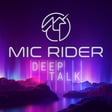
#20 Is ethical AI even possible? Deeptalk with Kurt Paulsen from Spawning.ai
In der neuen Folge Mic Rider Deep Talk spreche ich mit Kurt Paulsen – Universitätsprofessor für Film, Medienexperte und Berater bei Spawning AI. KI und Urheberrecht – zwei Themen, die oft im Konflikt stehen.
Doch muss das so sein? Wir reden über das "Do Not Train"-Register, das Künstlern mehr Kontrolle über ihre Werke gibt, und darüber, wie KI-Training fairer gestaltet werden kann.
Zum Beispiel mit einem foundation model, das transparent und rechtlich einwandfrei mit seinen Trainingsdaten umgeht. Spawning.ai trainiert gerade ein solches Bildgenerierungsprogramm.
Und was hat es eigentlich mit der Website “have I been trained” auf sich? Kurt teilt seine Sicht auf die Zukunft von KI: Wohin führt die Entwicklung? Welche Rolle spielt das Urheberrecht? Und welche Verantwortung tragen Entwickler und Plattformen?
Nachrichten an: deeptalk@mic-rider.com
Website: https://www.mic-rider.com/
Host und Redaktion: Patrick Messe (https://www.patrickmesse.at/)
Zu Gast: Kurt Paulsen (thekurtpaulsen.com)
Spawning AI: https://spawning.ai/
Have I been trained: https://haveibeentrained.com/
Bild: Charly Glawischnig (https://www.charlyglawischnig.com/)
Ton: Lukas Wurm (https://lukaswurm.com/)


